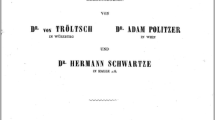Abstract
There has been an explosion in the computers and information technology in the past couple of years. Otorhinolaryngology has also seen a number of new applications of computers. This article aims to familiarize the reader with different uses of computers as applied to the field of Otorhinolaryngology. It deals with the role in medical literature search, patient and doctor education, medical record keeping telemedicine, internet and E-mail, creating virtual environments and its role in FESS. skull base tumours and plastic surgery.
Similar content being viewed by others
References
Vining DN, Padhani AR, Wood S, et al: (1993). Virtual bronchoscopy: A new perspectivefor viewing the tracheobronchial tree, Radiology 189: 438.
Klein MS, Ross FV, Adams DL et al: (1994). Effect of on line literature searching on lengthof stay and patient care costs. Acad Med 69: 489–495.
Lindberg DAB, Siegel ER: (1991). On assesing the impact of medical information: Does Medline make a difference? Methods Inf Med 30: 239–240.
Virre E, Warner D, Balch, D, et al: (1997). Remote medical consultation for vestibular disorders : Technological solutions and case report. Telemedicine journal 3:1.
Richart RH: (1970). Evaluation of a medical data system. Comput Biomed Res 3: 415–425.
Mamlin JJ, Baker DH: (1973). Combined time-motion and work sampling study in.a general medicine clinic. Med Care 11 : 449–456.
Internet Resource: Network Wizards Internet Domain Survey http://www.nw.com/.
Rothschild M: (1997). The Archives and the internet. Arch Otolaryngol Head and Neck surgery 123: 1015–1017.
Anon IB, Klimek L, Moseges R, et al: Computer assisted endoscopic sinus surgery: (1997). An international review. Otolaryngol Clin North Am 30:389.
Fried MP, Kleefield J, lolesz FA et al: (1996). Intraoperative image guidance during endoscopic sinus surgery. American journal of Rhinology 10 ; 337.
Tomura N, Miyauchi T, Shindo S, et al: (1993). Three dimensional computed tomography inhead and neck diseases with bony abnormalities. Comput Med Imaging Graph 17: 411 -420.
Constantian MB, Ehrrenprises C, Sheen JH: (1987). The expert teaching system: A newmethod for learning rhinoplasty using interactive computer graphics. Plast Recconstr Surg79: 278.
Author information
Authors and Affiliations
Rights and permissions
About this article
Cite this article
Handa, K., Deka, R. Computers in otorhinolaryngology; new horizons. IJO & HNS 51, 90–95 (1999). https://doi.org/10.1007/BF02998001
Issue Date:
DOI: https://doi.org/10.1007/BF02998001




